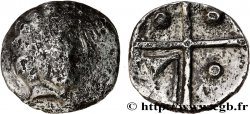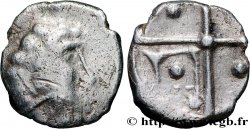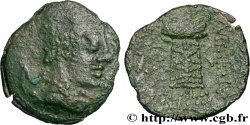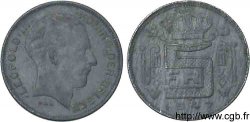Live auction - bga_1034948 - GALLIA - SOUTH WESTERN GAUL - LONGOSTALETES (Area of Narbonne) Drachme “au style languedocien”, S. 285
You must signin and be an approved bidder to bid, LOGIN TO BID. Accounts are subject to approval and the approval process takes place within 48 hours. Do not wait until the day a sale closes to register. Clicking on "BID" constitutes acceptance of the terms of use of cgb.fr private live auctions.
Bids must be placed in whole Euro amounts only. The sale will start closing at the time stated on the item description; any bids received at the site after the closing time will not be executed. Transmission times may vary and bids could be rejected if you wait until the last second. For further information check the Live auction FAQ
All winning bids are subject to a 18% buyer’s fee.
All winning bids are subject to a 18% buyer’s fee.
Type : Drachme “au style languedocien”, S. 285
Date: IIe siècle av. J.-C
Metal : silver
Diameter : 17 mm
Orientation dies : 3 h.
Weight : 3,55 g.
Rarity : R3
Coments on the condition:
Très jolie drachme bien centrée, dans un état rare pour le type. Patine grise
Predigree :
Monnaie provenant de la collection Eugen Wankmüller Munich
Obverse
Obverse legend : ANÉPIGRAPHE.
Obverse description : Tête à gauche, avec une sorte de diadème formé par la chevelure éparse ; cou avec bourrelet à la base.
Reverse
Reverse legend : ANÉPIGRAPHE.
Reverse description : Croix bouletée au centre, formée de quatre cantons, chacun ornés d’une lunule ; une oreille au 3e canton.
Commentary
Si le revers est un classique pour les languedociennes, avec une oreille dans un des cantons, le droit est nettement plus complexe : plusieurs monnaies types en sont proches, sans y correspondre exactement (cf. S. 285-286, 309)..
If the reverse is a classic for the Languedoc women, with an ear in one of the cantons, the obverse is clearly more complex: several typical coins are close to it, without corresponding exactly (cf. S. 285-286, 309).
If the reverse is a classic for the Languedoc women, with an ear in one of the cantons, the obverse is clearly more complex: several typical coins are close to it, without corresponding exactly (cf. S. 285-286, 309).








 Live starting :
Live starting :  Report a mistake
Report a mistake Print the page
Print the page Share my selection
Share my selection Ask a question
Ask a question Consign / sell
Consign / sell
 Full data
Full data










